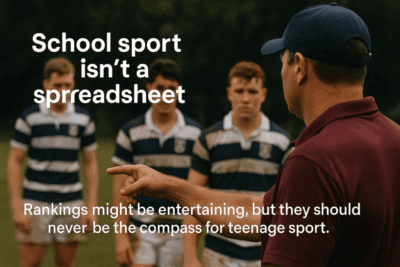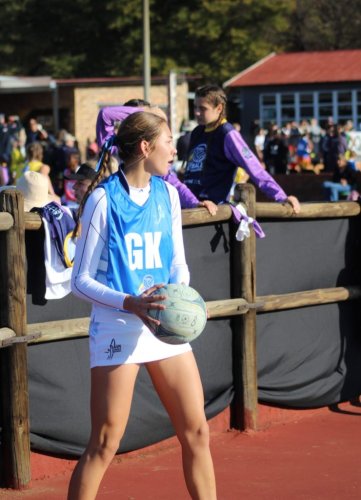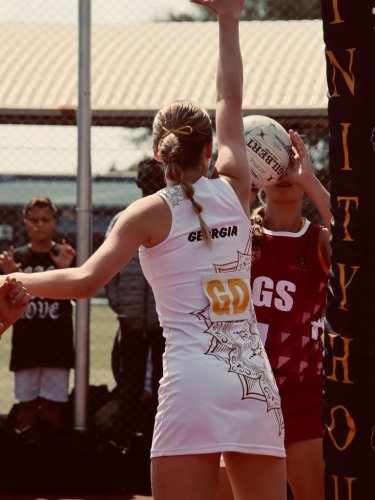Beyond the Rankings: Why school sport is bigger than a weekly ladder
 School sport isn’t a spreadsheet. It’s early-morning buses, muddy socks, festival friendships and that one moment when a shy kid finds their voice. Rankings might be entertaining, but they should never be the compass for teenage sport.
School sport isn’t a spreadsheet. It’s early-morning buses, muddy socks, festival friendships and that one moment when a shy kid finds their voice. Rankings might be entertaining, but they should never be the compass for teenage sport.
The recent article “6 Reasons Why School Sports Rankings Matter” repeats the same arguments we’ve heard for years: rankings give teams “purpose,” raise standards, create national conversation, help with sponsorships, and spotlight excellence. It even claims rankings “track results, not reputations.”
Here’s the problem: the maths behind these rankings isn’t neutral, and they’re definitely not reputation-free.
The “one number” myth
Most public ranking systems in SA take results, award bonus points for things like strength of opposition, margin, goals scored, venue—and in rugby, even Historic Strength—and then divide by matches to get an average that orders schools.
Sounds tidy. It isn’t.
- Small-sample bias: A school playing fewer games can hold onto a flattering average. A school that plays more fixtures introduces variance and gets punished. There’s no confidence interval, no margin of error—just a hard number that looks precise but isn’t.
- Margin of victory incentives: Any system that rewards margin—even if capped—creates pressure to keep starters on longer, run up scores, and manage games for the table instead of player welfare. That’s not what school sport should be about.
- Historic Strength: The claim that rankings “track results, not reputations” falls flat when reputation is literally baked into the formula. If your points are weighted by last year’s reputation, you’re not measuring results alone.
- Schedule distortion: South African school calendars are uneven. Some schools barely cross provinces; inter-regional fixtures are sparse. That makes transitive comparisons (“we beat those who beat them”) unreliable. A polished number hides shaky maths.
- Data quality: Festivals mean short turnarounds, different formats, astro versus grass, altitude versus sea level, home/away inconsistencies, and missing results. The formula treats all inputs as equal. They’re not.
Rankings distort behaviour
Beyond the maths, there’s a bigger issue: what happens when adults start chasing a ranking?
- Coaches optimise for the table rather than development: fewer rotations, fewer opportunities for bubble players, less willingness to experiment.
- It can push schools toward “fixture gaming”—picking opponents and timing to protect averages rather than stretch programmes.
That’s not raising standards. It’s narrowing them.
What actually raises standards
At SuperSport Schools, we see something different working every week. High-intent viewership isn’t driven by who’s 7th or 9th on a list. It’s driven by derbies, festivals, rivalries, and stories about young talent that communities rally behind.
That’s what builds sponsors’ value too: context, consistency, community. Not a number next to your school name.
If people still want rankings…
We’re not saying ignore data. But let’s do it better:
- Move from a single table to a dashboard. Track a Form Index (last five games). Show Fixture Strength Quadrants (A/B/C/D level opponents). Publish Development Minutes(how many U16/U17 minutes are being played in 1st teams). Flag a Welfare Lens(minute loads, blowout frequency). Add Equity Adjusters (context like travel demands and facilities).
- If a ladder must exist, put guardrails around it. Publish the full formula and weights, including how “Historic Strength” is set and decays. Show tiers with uncertainty, not a false 1–100 precision. Enforce minimum game thresholds and normalise festival conditions. Cap margins with diminishing returns, so there’s no incentive to chase 50-point wins. Recalibrate home/away adjustments annually.
That would at least make it transparent, credible, and less distorting.
Our choice
For us, the bigger scoreboard isn’t a number on a website. It’s how many kids are playing, how many parents are engaged, how many communities are connecting through sport. It’s how often school sport becomes a platform for growth, belonging, and opportunity.
That’s what we’ll have to continue to invest in within school sports.
Because school sport is about far more than a rank—it’s about moments, memories, and pathways that last a lifetime.










